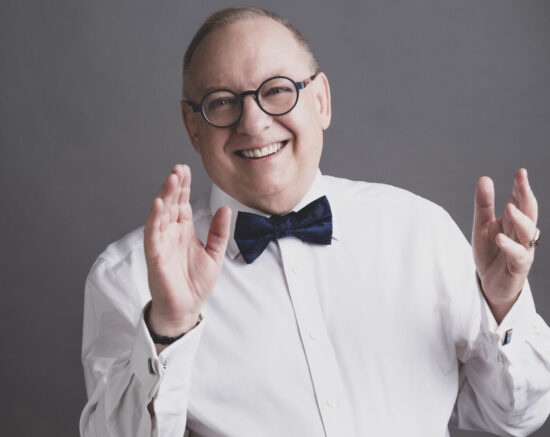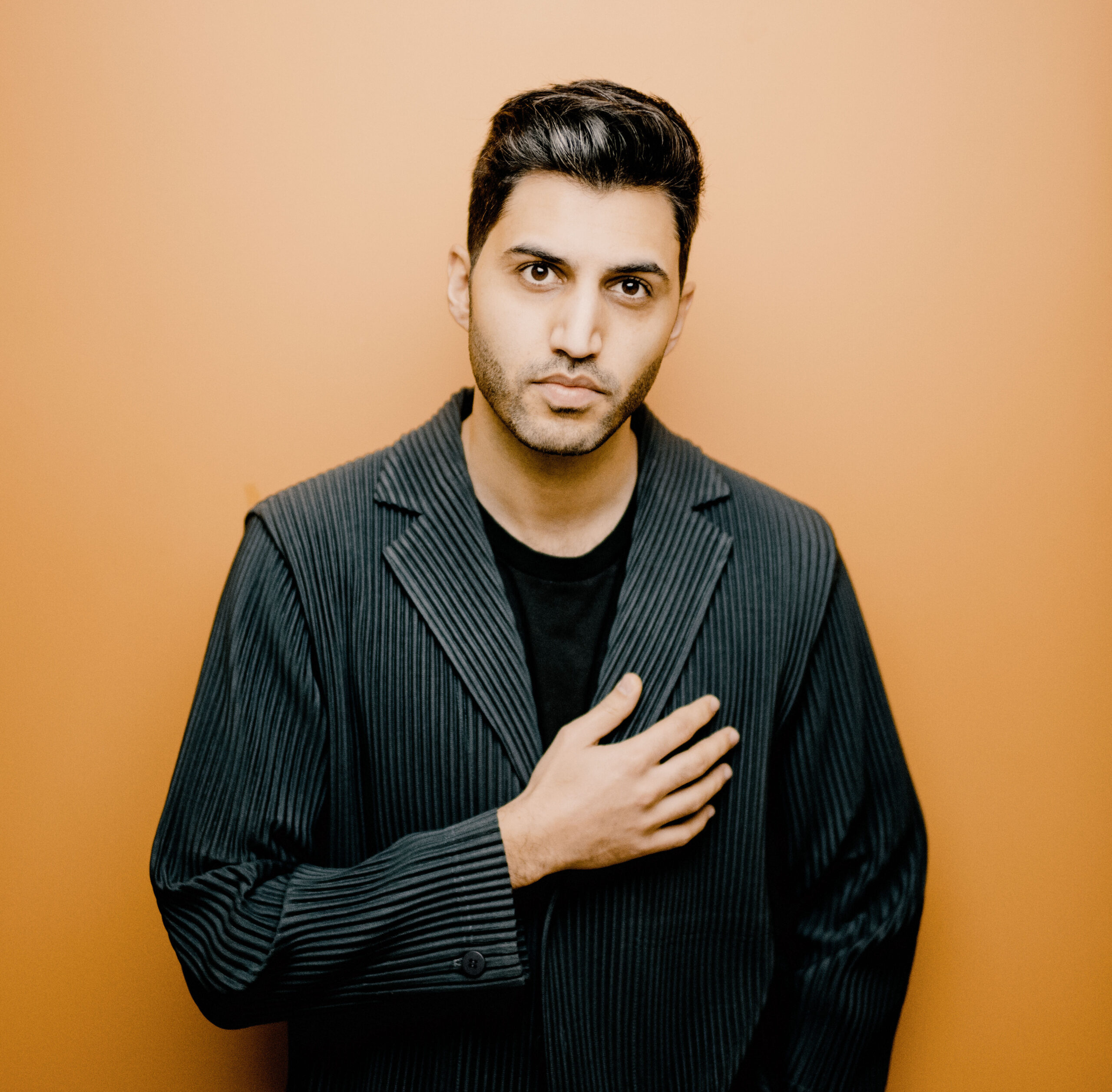Beethoven 7 (May 13-15, 2021)
Program
Stéphane Denève, conductor
Celeste Golden Boyer, violin
Death of the Poet (2014)
Felix Mendelssohn
- Violin Concert in E minor, op. 64 (1844)
- Allegro molto apassionato—
- Andante—
- Allegretto non troppo; Allegro molto vivace
Celeste Golden Boyer, violin
Ludwig van Beethoven
- Symphony No. 7 in A major, op. 92 (1812)
- Poco sostenuto, Vivace
- Allegretto
- Presto; Assai meno presto
- Allegro con brio
Program Notes
By Tim Munro
Stéphane on this program
From an interview with Stéphane Denève. Stéphane’s responses have been edited for length and clarity, and questions have been removed.
If Beethoven’s Ninth Symphony unites people with the idea of brotherhood, his Seventh Symphony unites people with the idea of dance. We dance, we connect, we share a space. The feeling is of going to a rock concert together—being close to each other, sharing energy.
Felix Mendelssohn’s Violin Concerto is gloriously beautiful. Mendelssohn is taken for granted, overlooked. But he is the equal of the greatest giants. It is sometimes said that his music is perfectly beautiful on the surface. But there is such depth.
TJ Cole’s Death of the Poet is inspired by a painting by Conrad Felixmüller. I don’t hear a literal depiction of the painting, but there is something haunting in Cole’s writing. The tremolo at the beginning and end of the piece—it has a certain presence. I judge a piece by its “soul presence.” The music takes you by the hand and leads you somewhere.
Death of the Poet
TJ Cole
Born 1993

TJ Cole is a Philadelphia-based composer whose music is crisscrossing the country, from Minnesota to Utah, from Tennessee to Michigan. They are particularly drawn to orchestral music, “because there are so many color possibilities.”
In high school, Cole visited the Art Institute of Chicago. There they stood, awed, in front of Conrad Felixmüller’s 1925 painting, The Death of the Poet Walter Rheiner. “It was overwhelming,” Cole says. “These dark colors—deep purples and blues and greens.”
Memories of the painting stayed with Cole, who wrote Death of the Poet as a student at the Curtis Institute of Music. Cole took advantage took advantage of Curtis’s incredible string players, scoring this work for string orchestra.
Death of the Poet is an elegy. The poet in Felixmüller’s painting, Walter Rheiner, died a tragic death at 30 years old. In the painting, Rheiner is seen jumping from a high apartment window. Cole’s music reaches deep into the cellos and basses, dredging darkness.
Cole experiences synesthesia, where one sense triggers another, different sense. In Death of the Poet, they were exploring the flexibility of string instruments, “trying to recreate the artist’s colors with instruments.”
| First performance | March 31, 2014, in Philadelphia, by the Curtis Symphony Orchestra |
| First SLSO performance | These concerts |
| Scoring | Strings |
| Approximate duration | 11 minutes |
Violin Concerto
Felix Mendelssohn
Born February 3, 1809, Hamburg, Germany
Died November 4, 1847, Leipzig, Germany

Felix Mendelssohn could not tolerate virtuosity for its own sake. Writing concertos, he took careful time to balance showiness with musical integrity. But threading this needle took time.
At 29, he was haunted by an idea for the opening bars of a violin concerto. At 30, he dreamed of a cadenza. At 34, he sketched a shape for the work.
Mendelssohn was a busy man. He whirred around Leipzig, directing the city’s main orchestra, conducting at the opera house, leading the choirs, founding a music conservatory.
At 35, Mendelssohn gathered his thoughts during an unusually restful summer and completed the Violin Concerto. It was written for violinist Ferdinand David, a childhood friend, and Mendelssohn leaned on David for all sorts of technical advice in writing the work.
The concerto has modest proportions, yet it launches a quiet revolution. Instead of orchestral preamble, the solo violin begins right away. Instead of breaks between movements, the music runs continuously. Instead of on-stage combat, there is conversation between violin and orchestra.
Three sides of the mature Mendelssohn rise to the surface. In the first movement, dark passion emerges from an elegant exterior. In the second, a hush falls, and the violin lulls us with a gentle song without words. In the third, the violin and orchestra scamper with childlike energy.
Mendelssohn didn’t know it, but at 35, he had only three years left to live. The concerto would be his final orchestral work.
| First performance | March 13, 1845, in Leipzig, Niels Gade conducting, with Ferdinand David as soloist |
| First SLSO performance | March 22, 1912, Max Zach conducting, with Albert Spalding as soloist |
| Most recent SLSO performance | January 27, 2018, David Robertson conducting, with Julian Rachlin as soloist |
| Scoring | Solo violin, 2 flutes, 2 oboes, 2 clarinets, 2 bassoons, 2 horns, 2 trumpets, timpani, strings |
| Approximate duration | 26 minutes |
Symphony No. 7
Ludwig Van Beethoven
Born December 16, 1770, Bonn, Germany
Died March 26, 1827, Vienna, Austria

A cramped city apartment is strewn with clothes, plates of rotting food. At a table, a short, stocky man hunches over a mess of papers.
Joy did not come easily to Ludwig van Beethoven. He lived the life of a successful freelance composer: his name on people’ lips, his living heavily subsidized. But he was worried by chronic illness, encroaching deafness, and loneliness. His diaries are full of pain and frustration.
What life failed, art rescued. Calling himself a tone-poet, Beethoven believed that music is more than beauty—it has moral and religious dimension. “Only art and science,” he wrote, “can raise people to the level of the Gods.”
The Seventh Symphony is a musical statement by a true believer. Its winds batter and unbalance. Much of the music is in major keys, yet the joy is defiant, its hand held in a fist. The symphony dances, but on the edge of a volcano.
Fascinated by a new invention, the metronome, Beethoven dictated how fast his music should be played. The speed of his markings pushes difficult music to the edge of unplayability: fingers stretched, tongues tied.
In person, Beethoven was often abrupt, then unapologetic. He was unafraid to bring any relationship to a sudden end. The Seventh Symphony, like the man, allows no compromise.
| First performance | December 8, 1813, in Vienna, the composer conducting |
| First SLSO performance | December 3, 1908, Max Zach conducting |
| Most recent SLSO performance | March 29, 2017, on tour at the University of Illinois, David Robertson conducting |
| Scoring | 2 flutes, 2 oboes, 2 clarinets, 2 bassoons, 2 horns, 2 trumpets, timpani, strings |
| Approximate duration | 36 minutes |
Tim Munro is the St. Louis Symphony Orchestra’s Creative Partner. A writer, broadcaster, and Grammy-winning flutist, he lives in Chicago with his wife, son, and badly behaved orange cat.
Program Notes are sponsored by Washington University Physicians.


